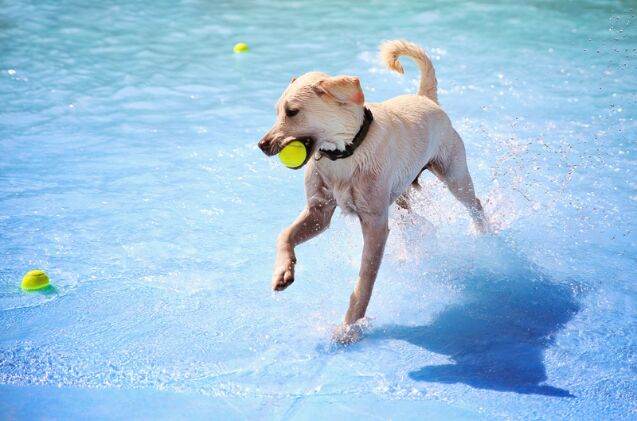What is Water Intoxication in Dogs?

Have you ever been warned about there being too much of a good thing? While water is essential for the health and well-being of our dogs, it also presents a surprising and often unknown danger: water intoxication.
A serious and potentially fatal health concern, water intoxication (hyponatremia) is a risk that every dog parent should be aware of – especially those with pups who enjoy water-related activities like swimming in the pool, catching water from the hose, or even visiting the dog beach.
In this guide, I’ll discuss the causes, symptoms, and prevention of water intoxication in dogs. Take a moment to read it through carefully. This information could save your furry friend’s life.
What is Water Intoxication in Dogs?
Water intoxication, or hyponatremia, is a medical condition that occurs when your dog ingests too much water in a short time. This impacts the electrolyte balance within the cells—more specifically, the sodium levels. It also causes the cells to swell.
When the cells of the brain swell, this can have a severe and life-threatening effect on the central nervous system.
Unlike some medical conditions that develop slowly over time, hyponatremia escalates very quickly. Medical treatment is needed as soon as possible. Even with quick action and veterinary care, not all dogs will recover.
Can a Dog Drink Too Much Water?
One of the first concerns that many pet parents have is the possibility of excessive water drinking in dogs. But is it possible for your dog to actively drink too much water, leading to water intoxication?
A healthy dog will not continue drinking water to the point of threatening their own life, although some have been known to gulp down enough to cause stomach upset. This usually happens after being overly active or engaging in heavy exercise.
If you notice your dog drinking excessive amounts of water, it could be a red flag of a more significant medical issue. Diseases and illnesses like diabetes, kidney problems, liver disease, and Cushing’s disease are all associated with increased thirst. Contact your veterinarian if your dog is drinking enough water to raise a concern.
How Common is Water Intoxication in Dogs?
If this information has you panicking or feeling overwhelmed, take a deep breath. Water intoxication is life-threatening for dogs, but it’s also incredibly uncommon. That doesn’t mean we shouldn’t familiarize ourselves with the risks, warning signs to look out for, and steps we can take to prevent a problem from developing.
What Dogs Are at Risk for Water Intoxication?
Your dog’s risk for water intoxication will depend largely on their favorite activities. Dogs who are high energy or participate in intense activities are at a higher risk of drinking an excessive amount of water, which can lead to trouble.
Additionally, dogs who enjoy playing in the water are at a higher risk. As dogs swim, they can swallow water. Some dogs will ingest more water than others, depending on their swimming skills and how they play. Activities that can lead to swallowing even greater amounts of water include snapping at a hose, sprinkler, or other moving water and playing fetch in the water, where they may ingest it while trying to pick up their toy.
This isn’t to say that you should avoid all water-based activities. There is nothing wrong with enjoying a fun day at the beach with your dog! However, we need to be aware of the risk and keep an eye open for any signs that something may be wrong.
How Do I Know if My Dog Has Water Intoxication?
To give your dog the best chance of survival, they must be treated by a veterinarian as quickly as possible. This means being able to identify the earliest signs of trouble.
Some of the more common water intoxication symptoms in dogs include:
- Excessive drooling
- Nausea
- Vomiting
- Pale gums
- Bloating
- Dilated pupils or glazed eyes
- Weakness
- Lack of coordination (stumbling, staggering, falling, having difficulty keeping their balance)
- Acting restless
If the condition is allowed to progress, it will cause severe and irreversible brain damage. This may trigger seizures or cause your dog to slip into a coma. They may also experience difficulty breathing at this stage. Unfortunately, in these severe cases, the likelihood your dog will survive is very low.
Any combination of the above signs warrants an immediate call to your veterinarian or a trip to the nearest emergency veterinary clinic.
Treatment of Water Intoxication
When you arrive at the veterinary office, they will assess how far the condition has progressed. If it is a mild case of hyponatremia, your vet may give your dog IV fluids to increase sodium levels while monitoring for any signs of further trouble. This may require a full day or even overnight in your vet’s care while they ensure there has been no lasting neurological damage.
In more severe cases, your vet may need to act faster to address the electrolyte balance and reduce swelling in the brain. Their treatment plan may involve:
- A more concentrated sodium solution
- Diuretics to help reduce and remove fluids faster
- Drugs to decrease pressure in the brain
- Extensive monitoring and hospitalization
Even if your dog responds well to the sodium solutions, balancing their electrolytes, it doesn’t mean they are in the clear. After your dog starts to stabilize, your vet will need to run tests to determine if there has been any lasting cellular or neurological damage.
Can You Treat Water Intoxication at Home?
No, water intoxication is a very serious condition that you should not attempt to treat at home. Every second you delay medical treatment from your veterinarian, it increases your risk of life-changing or fatal complications.
If you suspect your dog is suffering from hyponatremia, you need to get your dog to your veterinarian or the nearest emergency clinic as quickly as possible.
Tips for Preventing Water Intoxication in Dogs
Preventing a serious condition like hyponatremia is always better than trying to treat it, especially given how quickly it progresses. Here are a few simple tips and tricks to reduce the risk of water intoxication and help keep your dog safe:
Limit Water After Heavy Exercise
Have you been running and playing all afternoon with your dog? When settling in for a break together, offer smaller portions of water over time instead of a large bowl. This will allow your dog to rehydrate safely without running the risk of drinking too much water and making themselves ill (or worse).
Choose Safer Fetch Toys
The game of fetch is one of the most popular and common games associated with dogs – but is fetch itself the problem? You can play fetch safely, even in water environments. However, some toys are safer for this than others.
Tennis balls may be a classic, but they increase the risk of trouble. Tennis balls and other round, firm toys hold your dog’s mouth open as they swim back. This means ingesting more water after they have retrieved their beloved toy. Instead, consider choosing something flatter or that will flatten when held.
Some great options for a fun game of fetch at the beach include:
- West Paw Seaflex Sailz Flying Disc
- ChuckIt! Amphibious Boomerang Fetch and Float Dog Toy
- ChuckIt! Paraflight Flying Disc Dog Toy
- Kong Wubba Wet Floating Dog Toy
- BIONIC Toss-N-Tug Dog Toy
- Ruff Dawg Flying Fish Floating Dog Toy
Another critical point to consider when choosing toys to play with during water activities is to avoid anything that sinks. Your dog will swallow considerably more water reaching down to the surface of the lake or pool than they would if they were just plucking a floating toy from the surface. All the safe toys listed above float.
Take Regular Breaks
Whether you’re visiting the dog beach or spending the afternoon around the backyard pool, make sure your dog takes a break every 10 to 15 minutes of playtime. This helps to prevent water intoxication in several ways.
First, a regular timed break with monitored access to fresh water will allow your dog to rehydrate safely. Otherwise, your dog may drink excessive amounts of water while running and playing, even directly from the water they are in.
Additionally, it allows your dog to catch their breath. One of the ways that dogs end up swallowing a lot of water is by panting heavily while running through water. As your dog feels more exhausted, they are more likely to ingest even more. A break will allow them to catch their breath before returning to the water.
Pay Attention to How Your Dog Swims
If you have a dog that loves to swim, take a moment to watch how they swim. Do their front paws splash a lot of water up into their face? Do they swim with their head held high out of the water or down low, where they will likely swallow more?
You may need to teach your dog how to swim better, focusing on short sessions where you encourage them to swim confidently with their paws underwater. Some dogs will never learn to swim “gracefully,” even if they love it. If that’s the situation, you can outfit them with a high-buoyancy dog life jacket to make swimming easier and reduce splashing.
Skip the Hose
I don’t deny that it’s hilarious watching a dog snap at the stream from a garden hose, trying to catch the water before it hits the ground. However, this is an activity that can have very severe side effects. Any high-pressure water source spraying directly into your dog’s mouth will inevitably mean swallowing a considerable amount of water.
Instead, stick to safer water activities, such as playing in a small puppy pool or swimming at the dog beach. Of course, always supervise your dog during whatever activity you choose.
Don’t Skip Your Dog’s Yearly Checkup
There are several health conditions that could increase thirst, encouraging your dog to drink excessive amounts of water. Maintaining your dog’s regular checkups will allow the vet to check for signs of trouble and catch illnesses and diseases earlier.
Conditions like liver disease and diabetes can’t be reversed, but they can be managed. Keeping these in check will help your dog feel better and reduce the temptation to drink more water than they should.
Final Thoughts: Water Intoxication in Dogs
If your dog is suffering from water intoxication, it is a serious and potentially life-threatening situation. While there are no guarantees, to increase their chance of survival, get your dog to a veterinarian, either your regular vet or the nearest emergency clinic, as quickly as possible for treatment.
You don’t have to eliminate all water-related fun from your dog’s life. It's about finding the right balance between safety and enjoyment.
There are steps you can take to reduce the risk and help keep your dog safe. This includes choosing a safer toy for play at the beach, avoiding encouraging your dog to bite at high-pressure water streams, like a hose, and taking regular breaks during any water fun.
Have a great summer, complete with all the water games and activities your dog loves most!
Join the PetGuide community. Get the latest pet news and product recommendations by subscribing to our newsletter here.

Britt Kascjak is a proud pet mom, sharing her heart (and her home) with her “pack” which includes her husband John, their 2 dogs – Lucifer and Willow – and their 2 cats – Pippen and Jinx. She has been active in the animal rescue community for over 15 years, volunteering, fostering and advocating for organizations across Canada and the US. In her free time, she enjoys traveling around the country camping, hiking, and canoeing with her pets.
More by Britt
























